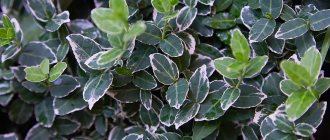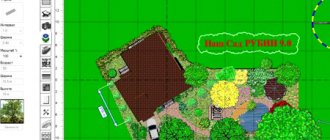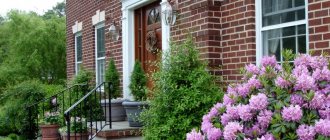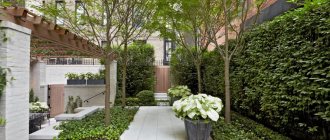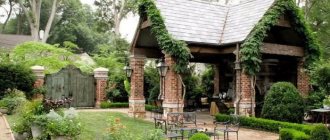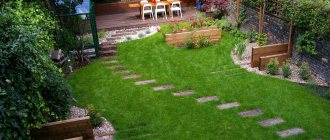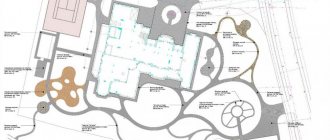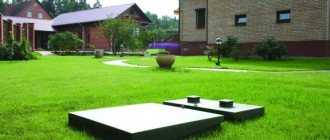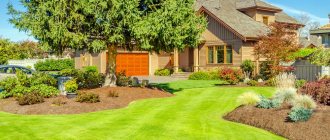Not everyone has room in their yard for a giant ship pine or huge oak tree. But fortunately, there are many dwarf trees suitable for small gardens. Such trees usually grow no more than 4-4.5 meters in height. Not only do they fit easily into landscape designs, but they are also less labor-intensive to maintain than large trees. In this article I would like to talk about my favorite short trees that are worth paying attention to when landscaping a small garden.
Popular short trees for landscape design
Advantages of short trees
Although dwarf trees are small in size, they can still make a big contribution to the landscape. We love dwarf breeds for their miniature size, unique shapes and, of course, the color of their foliage or flowers. When choosing trees for small gardens, it is essential to find out the maximum height of the tree and how long it will take for it to reach that height. Some species grow slowly and initially fit very well into a small garden. But over time, they can grow too large and take up all the available space, blocking light and potentially damaging the foundation of your home.
Fortunately, there are many species and cultivars of trees that are compact in size and remain compact throughout their lives. A correctly selected and well-placed tree will become an attractive center of attention and will arouse interest throughout the year. Pruning is usually an easier task in this case.
If you have a small yard, focus your attention on vertical space. That is, choose plants that grow upright and have a narrow crown to make the most of the available space.
In addition to decorative foliage plants that will brighten the garden all season long, or beautiful flowering plants that produce a wave of blooms in spring or early summer, look for trees with berries to attract birds and provide them with nesting sites.
If you don't know where to place your tree, growing it in a pot may be a solution. In this case, you can place it in different places and take it with you if you move. This growing method is also useful if you need to protect a heat-loving tree in winter by moving it to a frost-free room.
How to care for a fruit “mini garden”
The basic rules of care include systematic loosening of the soil, removal of weeds and other vegetation. To avoid the appearance of crusts on the ground, you will need to mulch the soil. Compost is used for such purposes.
Particular attention is paid to the soil during the dry season. To retain moisture, the soil is covered with hay. Mulching is carried out so that the layer is not located too close to the trunk. It is not recommended to apply mulch during wet periods.
Watering
It is recommended to water the mini garden weekly. 2 buckets of water should be added to 1 seedling.
Fertilizers
It is best to fertilize after the soil is moistened. For dwarf plantings, fertilizing with mullein or chicken manure is ideal. It is recommended to dilute mullein with water in a ratio of 1 to 10, and chicken droppings - 1 to 20.
Diseases
Most often, gardeners encounter powdery mildew, mosaic and cytosporosis. The first disease manifests itself in the form of a white powdery coating. This is a fungal disease that progresses quite quickly. Fruits on such trees may not bear fruit and may become deformed. As preventive methods, it is recommended to carry out systematic pruning, remove debris and fallen fruits. Thickening of the crown is not allowed. In spring, it is recommended to spray with Bordeaux mixture. If the plant is damaged, it is recommended to remove all damaged parts and burn them. It is also recommended to use the preparations “Tiovit Jet”, “Topaz”, “Quadris” for treatment.
Mosaic appears as green or white spots on leaves and fruits. This is a disease of viral origin. Leaves may become deformed and development may slow down. Often the disease occurs due to treatment with instruments that are not disinfected. Minor damage can be treated with Karbofos.
Cytosporosis is manifested by brown shades of the crown, the appearance of bumps and roughness. Treatment will only help in the early stages. All damaged areas are removed and burned. Then the trees are treated with Bordeaux mixture, also fed with ash and whitened with lime.
Properly selected dwarf trees for the garden will harmoniously complement a small area, fill it with beauty and provide fruit.
Ash maple "Flamingo"
Flamingo ' is a delightful little tree. Its young leaves turn bright pink in spring before turning green with a bright pink edge, which subsequently fades to creamy white, retaining a very light pink tint.
Unlike the common ash-leaved (American) maple in urban landscaping, this variety is not very winter-hardy and never grows tall. In the middle zone, it is usually grown as a coppice crop, that is, having frosted over this small tree (up to 5 m tall), it is restored from the root in the spring, remaining the size of a bush (2-2.5 m).
The lighter, brightly colored maple foliage contrasts well with darker coniferous or deciduous plants and flowers. Suitable for all soil types as long as good drainage is provided. Can be grown in full sun or partial shade. Trimming improves foliage color.
Acer negundo 'Flamingo'. © hopesgrovenurseries
Juniper
It protects the peace and well-being of the owners of the house and is considered one of the most powerful protective trees. Juniper is able to cleanse the energy field of negative programs, get rid of damage and love spells.
To clean the house well, it is enough to periodically fumigate it with smoke from juniper branches. You need to plant a tree in front of your house.
Decorative apple trees
Add dramatic seasonal color to your landscape with ornamental apple trees (Malus). This group includes plants with purple foliage, carved leaves, but their main decoration is flowers in various shades of white, pink and red, and in the fall they bear orange, gold, red or burgundy fruits. One of the most popular varieties of ornamental apple tree "Royalty" with dark pink flowers, reddish-purple foliage and high disease resistance.
Decorative apple trees have a weeping, round or columnar crown shape. The height of such apple trees can vary, but usually does not exceed 4 m. Growing conditions are open sun, average humidity, well-drained soil. In some varieties of ornamental apple trees, the fruits may be edible, but they are often tasteless or even cause symptoms of poisoning, which must always be taken into account.
Ornamental apple tree (Malus), variety “Royalty”. © Sylvi
Rose hip
It personifies love feelings and experiences, helps to fan the fire of passion between lovers, and return the former ardor to the relationship. A rose hip planted near a house attracts money. Knowledgeable people advise planting it near the entrance doors or windows.
It is believed that the thorns of the plant effectively scare away evil spirits, allow you to get rid of energy vampires, and also serve as reliable protection against damage, love spells and the evil eye.
Iva "Hakuro Nishiki"
Hakuro Nishiki is the ideal plant to liven up dull spaces and give them an attractive appearance. The rounded silhouette of this miniature tree makes it an excellent accent plant. A problem-free large bush or small tree (up to 3 m tall), which grows quickly and will become a real highlight of the landscape. It stands out for its bright, color-changing leaves, thanks to which the bush may appear pink from a distance.
The young leaves of this willow are pink in spring, after which they turn white and green, and by autumn they turn yellow. One of the best qualities of this shrub, besides its color, is the soothing sound the leaves make when the wind blows over them.
The Hakuro-Nishiki willow is considered a low-maintenance shrub and can be easily grown in fertile soils that are well drained but constantly moist. Although it tolerates drier soils compared to other willows, it still requires regular moisture. This willow lends itself well to pruning. You can also often see it on sale in the form of a grafted tree on a trunk.
The only problem that can arise with such a willow is partial freezing of the branches in a harsh winter, however, the tree quickly recovers.
Willow whole leaf "Hakuro Nishiki" (Salix Integra Hakuro Nishiki)
Read also our article Variegated willows in my garden are beautiful at any time of the year.
Gardening for spring
Magnolia trees
Spring is for flowers. When the snow recedes and life returns, you need color, lots of color. This is one reason you can forgive this glorious tree for being only a spring wonder. Its critics note that it is of no use beyond the short period of the spring season when it blooms.
But nothing adds color like flowers, be they annuals, perennials, shrubs or trees. Any landscaped yard will have at least one flowering landscape tree of exceptional beauty.
Magnolia trees (Magnolia spp.) are some of the most spectacular specimens. Star magnolias often bloom earlier, while saucer magnolias bloom more heavily.
Apple trees
You don't have to be a farmer to grow apple trees (Malus spp.) in your yard. It's more than just fruit. Apple trees themselves have beautiful flowers. Fruit is already a bonus. If you don't care about growing edible fruit, apples will serve your purposes better.
A variety with rose-red flowers that reaches a height of 6 to 7 meters is Malus x Centzam or Centurion, which can be grown in almost any climate zone.
Dogwood trees
You'll probably want more than just flowering landscape trees that create a floral extravaganza in the spring. Luckily, sometimes in landscaping you get a two-for-one bonus.
In this case, these are dogwood trees (Cornus florida and Cornus kousa). They are unique in their capabilities: blooms in the spring, vibrant foliage in the fall, berries to attract wild birds in the winter, and interesting branching patterns year-round.
Alder buckthorn "Fastigiata"
Alder buckthorn "Fastigiata" (Frangula alnus 'Fastigiata', Ron Williams) is an original compact tree with a columnar crown, which from a distance can resemble a cypress. This is a persistent, hardy plant that does not require special care. The slow-growing tree is often grown as an addition to Japanese gardens or as the centerpiece of small arrangements. In adulthood it reaches a height of about 2.5 m.
The leaves are narrow, light green in summer and bright yellow in autumn. The bark is interesting for its bright color, so the tree is beautiful even after the leaves have fallen. Can grow in full sun, but develops better in partial shade. The breed is so frost-resistant that it can easily be grown in open ground or in containers (frost-resistant down to -40 °C). Almost any soil is suitable for buckthorn, except swampy ones.
Alder buckthorn "Fastigiata" (Frangula alnus 'Fastigiata', Ron Williams). © springmeadownursery
Acacia
The tree feeds energy because it is a donor. Symbolizes purity, purity and rebirth. It promotes the birth of a new life, so it is recommended to plant it for couples who want to have a child.
In terms of energy, acacia is closer to women. It promotes peace, eliminates sadness and melancholy.
Rowan
Most mountain ash (Sorbus) have beautiful feathery leaves, snow-white spring inflorescences and bright autumn berries. These are excellent trees for attracting garden birds such as robins and blackbirds. They like rowan berries, which are rich in nutrients.
An excellent choice for a small garden would be sweet-fruited varieties of rowan, which do not grow large and have a very original appearance. For example, the rowan "Pomegranate" with very large burgundy-red edible fruits does not exceed 4 m. Or the rowan "Titan" with sweet and sour cherry-red berries, 3 m high. The variety "Pendula" is a real sculpture in the garden, so how this weeping rowan forms strange shapes on a trunk and does not grow tall.
I also advise you to pay attention to the Kene rowan or its relative Kashmir , which amaze the imagination with snow-white or slightly pinkish fruits. The foliage of this rowan tree is more delicate and bright red in autumn. Often found grafted onto a standard. The height of the tree is 3-4 m.
Rowan (Sorbus aucuparia), variety "Pendula". © Floraplanet
Rowan (Sorbus), variety "Titan". © praskac
Rowan Koehneana (Sorbus koehneana). © Oregon State University
Whether or not to plant a tree near the house is another important nuance
There is one more rule that concerns planting trees near the house. There is a popular belief that some plants should absolutely not be planted near human habitation.
Some plants have a special aura, which does not always have a beneficial effect on the fate and well-being of the owner of the house and his family members.
According to bioenergetics experts, the aura of a tree really affects the physical condition and emotional state of people, as well as their thoughts and well-being.
Plant energy researchers divide all trees into donors and so-called vampires.
The former take the negative energy of the people living in the house and transform it into positive. The latter only know how to absorb positive energy, so a person often feels a loss of strength, suffers from headaches and nightmares.
Hazel
Fruit varieties of hazel or hazelnut ( Corylus avellana
), which are grown mainly for their nuts, are also usually small trees 3-4.5 m and are well suited for small gardens, although it must be borne in mind that they usually have a fairly wide crown.
Decorative varieties of hazel grow more slowly and are more compact; in addition, they usually have a very original appearance. For example, hazel "Contorta" with twisted branches and deformed green leaves. Or "Red Majestic" hazel, which also has twisted branches and clenched leaves that are bright red. Both trees do not exceed 3 m.
The Pendula hazel has a very unusual appearance of an umbrella or hut with a weeping crown, which has a height of 2 m and a width of 2.5 m. The decorative hazel Aurea , 3 m high, which can become a good partner for numerous red-leaved varieties hazelnuts
Hazel prefers fertile, moisture-absorbing soils and does not grow well in dry conditions. The place should be sunny or slightly shady.
Hazel or hazelnut (Corylus avellana), variety "Red Majestic". © The National Gardening Association
What to do with old trees growing near the house
Sooner or later, the owner of the plot faces the problem of finding an old tree near his home: some of them have already lost their attractiveness, others occupy a large space and interfere with the planting of young trees.
Some owners trust professionals to cut down a tree near their house, while others try to remove the old or disturbing tree themselves.
The decision must be balanced and responsible. Often the issue here is not only about the safety of the house and the owner of the site.
There are many superstitions among the people that do not advise destroying growing trees near the house.
Firstly, a tall tree with positive energy, which carefully covers the house with its branches, serves as a reliable talisman for both the home and household members.
Secondly, many old trees, especially those inherited from the previous owners of the site, can be protective talismans or havens for any human souls that have not left our sinful world.
Dwarf conifers
Conifers can make excellent dwarf ornamental trees. They can be easily trimmed and trained to remain short throughout their lives. Small specimens can be found in almost all popular coniferous tree species.
For example, thujas with a columnar crown for small areas: “Yellow Ribbon” (4 m), “Sunkist” (3 m), “Rheingold” (2-3 m), “Malogna Holub” (1 m), “Holmstrup” ( 3 m), "Green Egg" (2 m).
Louisiana three-lobed
Louisiana three-lobed, or almond, or three-lobed plum (Prunus triloba) is a stunning analogue of sakura for the middle zone. It is a small dense, round, multi-stemmed tree 2-3 m high (but if necessary, it can be easily maintained at half this height by trimming).
At the end of April-May the tree becomes unusually beautiful. Pink double or semi-double flowers with a diameter of up to 4 cm bloom on it, which densely adhere to the entire upper part of the crown, as if glued to the branches. The tree also has an autumn yellow-bronze color.
Louisiana's leaves, elongated oval in shape with finely toothed edges, provide light shade during the summer months for perennials growing under its canopy. The tree will withstand the harshest winters and is resistant to most pests and diseases.
An avenue of blooming almond trees will create an impressive border along a walkway, patio or lawn, and the tree will look great in a garden pot.
Triloba plum is best grown in moist, fertile, well-drained loam in full sun or partial shade (blooms best in full sun). Monnilia can sometimes become a problem, but hybrids with plum species are not severely affected by this disease.
Louisiana triloba, or almond, or triloba plum (Prunus triloba)
Dear readers! If you're looking for a small tree for a small garden, also consider shrubs. Many tolerate pruning well and can be raised to give the appearance of a small tree. But at the same time, they will be lower than many trees, reaching a height of 3-3.5 m. Try this, for example, with viburnum, lilac, dogwood, bladderwort, paniculata hydrangea or elderberry.
Fast-growing shrubs for the garden
Along with trees, deciduous, coniferous and berry bushes are grown in summer cottages. In small areas they can be found even more often than trees, since the compactness of the crown allows you to save space. In addition, shrubs are more versatile: they are used for zoning a site, creating hedges, and being incorporated into flower arrangements and flower beds.
Coniferous fast-growing shrubs
Cossack juniper (Juniperus Sabina) grows quite quickly. It rapidly grows in width, forming dense masses. It has the ability to take root by shoots: branches that are bent and in contact with moist soil take root and produce new shoots.
Horizontal juniper (Juniperus horizontalis) does not lag behind its relative Cossack in growth rate - its annual growth is 15 cm. Rising above the ground by only 30 cm, in the horizontal plane it can cover an area of 5 m.
Advice. To quickly fill the garden, it is recommended to buy coniferous plants at 4-5 years of age, always in containers. Planting is carried out with minimal damage to the root system, due to which adaptation is quick and painless, and the plant gives good growth already in the year of planting.
Deciduous shrubs
Deciduous ornamental shrubs can change the landscape in just 2-3 years, since many of them grow very quickly. The top 6 in terms of speed of green mass growth include the following plants:
- Viburnum foliage - if the bush is not trimmed, it grows up to 3 m in height. The branches are densely leafy, blooming with white inflorescences in the first half of summer;
- Mock orange - in some areas known as jasmine, but this is a different plant. A very viable and unpretentious shrub, valued for its abundance of flowering with fragrant, loose inflorescences and rapid growth;
- Various types of summer-flowering spirea (vangutta, oakleaf, arguta, gray). It is unpretentious, frost-resistant, and easily tolerates drought. In the month of June, thin branches bend to the ground under the weight of white inflorescences, which is why the plant is sometimes called the “white bride”;
- Common viburnum - loves moist soil and is not afraid of low temperatures. The branches are weakly branched, attractive in the fall with red clusters of berries;
- Lilac - forms many shoots that stand as a solid, impenetrable wall. It is loved by many summer residents for its large fragrant inflorescences of lilac and white color;
- Cotoneaster is a dense shrub with long, downward-sloping branches; there are creeping forms. All cotoneasters grow quickly, but the variety Parkteppich stands out especially. Last year's leaves fall off only after new ones grow, so the plant can be conditionally classified as evergreen.
